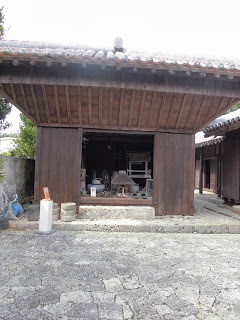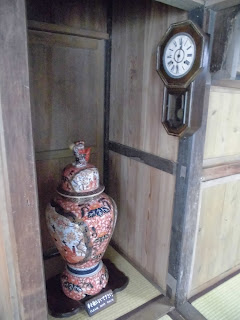During our second full day in Okinawa, we went north a bit to check out some castle ruins. I had been to them before, but my partner in travel had not. On the way to Nakagusukugusuku, we followed a sign into the Nakamura house. Somehow, I had missed this place in all the times I had previously been to Okinawa. What is the Nakamura house? It's an amazingly well-preserved, traditional house. The family who lived in it was definitely not poor, but they were not amazingly wealthy noblemen either, so this house gives you an idea of how average Okinawans lived back in the day.
在沖繩第三天,我們去看在中部的古跡。快要到一座(叫「中城」的古跡)我們看到一個看板告訴我們有一棟叫「中村家」的房子。這就是沖繩的傳統民家。在戰爭中,大部分的民家被爆炸破壞了,但是這一棟還在。
土曜日、沖縄にいる三日目、ちょっと中部辺りにグスクを見に行って来た。中城城に行っている途中、下の看板を見掛けて、急に行く事にした。沖縄はもう何回も行った事あるけど、この中村家住宅は今まで見落としてしまった。この住宅は沖縄に数少ない残っている伝統的な民家だ。戦争の被害を奇跡的に逃れて、今は博物館になっている。
The house is surrounded by a wall.
房子周邊都有牆。
まずは、回りに塀がある。
房子周邊都有牆。
まずは、回りに塀がある。
Here's the entrance...
進門去,,,
そしてここは入り口だ。
Upon going through the entrance, we're presented with another wall directly in front of us. This is a feature of traditional Okinawan homes. It's said to keep out bad spirits, but practically, it also provides more privacy.
還有另外一面牆。沖繩傳統的房子都有。是為了不讓鬼進來。
外の塀に入ってみたら、もう一つの塀がある。これは邪悪を除く為の塀だと言われている。また、実用的には外から家の中が見えない様にしているという役割もあるだろう。
On the roof is a Shisa, a guardian dog/lion that is seen all over Okinawa.
在屋頂有一隻ㄒㄧㄙㄚ。由來是跟金門的風獅爺或是中國的石獅子差不多。
屋根の上に凄いシーサーがいた。
The inner wall at the entrance is short, and we can go around it to the right or the left.
中の塀は短くて、右回っても左回っても入れる。
And here's the house itself. The interior is very much like a traditional Japanese house.
房子裡面好像日本的一樣。
家自体は大和式とほぼ一緒だ。
A storage shed.
倉庫。
For some reason, there was also a display of stamps issued while Ryukyu was under American military control.
美軍統治時代的郵票。
家の歴史と全く関係ないけど、米軍統治時代の切手も展示されている。
A bird in the yard.
この鳥めっちゃ綺麗だ。よく沖縄で見掛ける。
This unfortunately blurry photo is of the family altar to the ancestors. These altars are seen in Ryukyu and Japan, though I've heard that the Ryukyuan ones tend to be larger.
家裡的祭壇。是為了對先祖拜拜。
これは仏壇だ。基本的に大和の仏壇より琉球の仏壇の方が大きいと聞いた事ある。(詳しく知らないけど。)
A kimono.
沖繩的和服。(「琉服」嗎?)
琉球の着物。
Here's the underside of the roof.
屋頂下面
屋根の下はこうなっている。
食器などの名前を見るのも面白い。ウチナーグチと日本語の「似ているけど似ていない」ギャップは興味深い。個人的に、「やかん」の「ヤックヮン」は気に入った。
A shrine in the kitchen to the "Fi nu Kan", the god of the hearth. Like in China, the god of the hearth is considered a very important god who is responsible for the well-being of the family.
在沖繩有一位神叫名「火的神」。祂好像灶神一樣。(可能原來就是一樣的神。琉球受到很多中國的影響。)
「ヒヌカン」は「火の神」という意味だ。昔はどの家庭でも必ず台所に小さな祭壇が置いてあって、現在も珍しくないと聞いた事ある。この間「竈神」(普通は左の字をその複雑な字じゃなくて、火偏+土と書くけど)の事を初めて知って、偉い沖縄の火ぬ神に似ているなぁと思った。もしかして同じ由来があるかも。竈神は中華世界にある神で、家庭一戸一戸の台所に拝まれている。

And here's the top of the roof.
In the back of the house, next to the toilet, we have the pig pens.
在房子後面也有廁所,也有豬的圍場。
家の裏には便所とその隣りに豚小屋がある。明治時代まだは日本人は基本的に肉を食べなかったと違って、琉球人は各家庭に豚小屋があって、豚肉料理を満喫した。
Pigs will eat anything, and the fact that the pig pens and toilet are next to each other is no coincidence.
Artsy shot.
...or maybe this angle is better?
A machine used in the processing of sugar.
為了把甘蔗做成糖的機器。
砂糖を作る為の何かの機械だ。
And we're back outside!
Conclusion: the Nakamura house is very cool. Definitely go if you're in Okinawa.
中村家非常好!去沖繩就非去不可!
中村家住宅は本当にいい。沖縄に行けば、お勧めします!

































Very cool. This is one of the major sites I've yet to go to (along with most of the gusuku).. I'm hoping to visit Okinawa next fall, and hopefully, I'll get a chance to poke up to Nakagusuku, and check out the Nakamura house.
ReplyDeleteHow did you get there, by the way? Is it difficult to get to without a car?
I rented a car for the weekend, so that's how I got there. Okinawa is always easier with a car, but getting to Nakagusuku and the Nakamura house by bus might not be so bad. They're not very far up north, so going from Naha won't take that long.
Delete